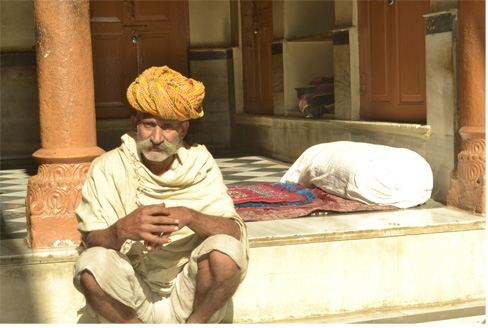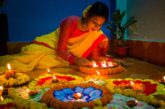
It is not very pristine in India, when a person would not forget to wear a symbol of his identity & honour, the turban, before leaving his house. Be it to heading out of the house for his daily business routine or to go a social gathering, Turban was a mandatory headdress for a Rajasthani . The colourful, charming headdress without which a man was supposed to be incomplete is heading towards obscurity . Although its not completely out of the world object as of now and we can see some elderly men wearing turban on the streets in contemporary time also, but the crown of the pride, which used to serve the purpose of saving the man from the scorching Rajasthani heat is itself feeling the heat of the time. The new generation has completely drowned away from this lovely headpiece & turban has been left with only ceremonial values for some special occasions like wedding.
Pride & Respect
The fascinating colourful turban called pagdi, pagh or safa is traditionally considered the crown(Taj) on the head of a man. A man could easily be identified because of his Pagh, so the turban was of much more value than a mere cloth to wear (more details at resume-for-you.com). A man used to be very attached to his turban. It was not only the men, but children of the house were also taught to respect the pagari of the family head, as it was pride & respect of the family. In fact, most of the time, word ‘pagri’ & respect or pride used interchangeably. We have numerous sayings in India showing the importance of turban in the Rajasthani milieu. If a person get insulted in public then its called ‘pagadi uchalna’ and if its to mortgage somebody’s respect its called ‘pagdi girvi rakhna’ . So its easy to understand that any reference to turban, good or bad, could & can have a direct impact on self-esteem of an Indian man & specially more common in Rajasthan.
Symbol of Identity
Geographically, Rajasthan is the largest state in India for now & the whole state can be divided into different regions. There are regions called Hadoti, Mewar, Shekhawati comprised of three- four or more districts. During Old good times, Pagadi not only served the purpose of Taj(crown) but it had identity values also. A person with a particular style of tying the pagh could easily be identified as a person of a specific region, religion. As they say, in India, language changes at every 40 miles; the style of tying the turban also change with miles. Each region has its own style of tying & colors of Pagri. Even within a region, there were different styles of tying the turban depending on different castes in a cast & class dominated society. While the Rajputs from a royal family will have one style of turban, local business man or a preacher will have different styles of tying the headpiece of the pride. Its not only color & style of tying but the length of the turban cloth also vary from province to province & caste to caste. The styles of tying & colors of turban were the representation of caste, religion, region a man belongs to.
Authority
The turban was not only a piece of pride only, but socially it was a symbol of authority also. A family head who used to be the main care taker of house was supposed to wear the turban & in case, if he dies , his eldest son is transferred the pagdi through a ritual called rasam pagri. The transfer of pagdi used to be symbol of transferring the responsibilities & authority. A family head with pagri used to have final rights to take decisions in favour of the family. He used to be main decision makers & society would pay attention to his words on social gatherings.
Vividness of Multicolour Tradition
Turban covers the spectrum of almost all the possible colors. It comes with incandescent luminosity. The beauty of the fact is that there are colors available for almost all the seasons, all the occasions & all the positions. The turban was representation of caste , region & occupation of a man and the color of turban used to play a great role to make the difference clear. You name the color & a turban is available with that. From white to black, green to blue, red or orange, yellow or gray, turban is in love with all. The fascination of the turban lies in colors. The use of color used to vary according to seasons also. If its spring, turban used to present itself in happy yellow or satrangi( seven colours) & if it is a time of winter near Diwali, pulsating reds and shocking pink dominates the desert. Colors changed according to ceremonial occasions also. If it’s a wedding, the turban will come as red bandhini (tie-dye) safas worn by the guests and it adds gravitas to the groom sitting on a white mare in a golden yellow color with long loose train hanging on the back . If its rasam pagri(on death of family head) it comes as white pagri. Turban have seen the time when it was tied by the men driven by passion & fandom for it.
On the verge of declared to be endangered
Despite of being the integral part of daily routine & pride & respect of the man, turban is unable to bear strokes of cruel modern time. New generation finds no use of the turban other than ceremonial occasions. Young chaps are busy building their career & racing to get ahead of the time & turban is lagging behind in the race. It seems to be the talk of all together a different time when the turban used to be integral part of the life.
” Write.. ..Write the article, because the time is reaching when turban will be available in articles only”, said an elderly person with his hands on turban & eyes in endless depth of time, when was enquired about the turban by me.





